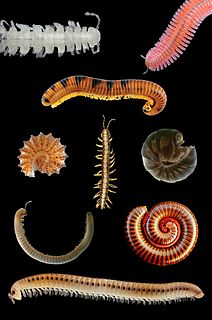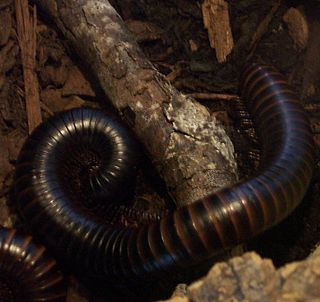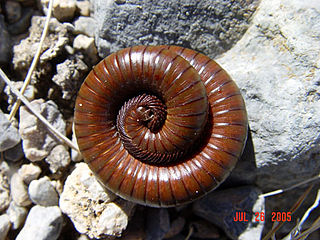
Millipedes are a group of arthropods that are characterised by having two pairs of jointed legs on most body segments; they are known scientifically as the class Diplopoda, the name derived from this feature. Each double-legged segment is a result of two single segments fused together. Most millipedes have very elongated cylindrical or flattened bodies with more than 20 segments, while pill millipedes are shorter and can roll into a ball. Although the name "millipede" derives from the Latin for "thousand feet", no species was known to have 1,000 or more until the discovery of Eumillipes persephone, which can have over 1,300 legs. There are approximately 12,000 named species classified into 16 orders and around 140 families, making Diplopoda the largest class of myriapods, an arthropod group which also includes centipedes and other multi-legged creatures.
Mardonius was a leading Persian military commander during the Persian Wars with Greece in the early 5th century BC who died at the Battle of Plataea.

Paulo Emilio Vanzolini was a Brazilian scientist and music composer. He was best known for his samba compositions, including the famous "Ronda", "Volta por Cima", and "Boca da Noite", and for his scientific works in herpetology. He is considered one of the greatest samba composers from São Paulo. Until his death, he still conducted research at the University of São Paulo (USP).

Ralph Vary Chamberlin was an American biologist, ethnographer, and historian from Salt Lake City, Utah. He was a faculty member of the University of Utah for over 25 years, where he helped establish the School of Medicine and served as its first dean, and later became head of the zoology department. He also taught at Brigham Young University and the University of Pennsylvania, and worked for over a decade at the Museum of Comparative Zoology at Harvard University, where he described species from around the world.

Doratogonus is a genus of millipedes in family Spirostreptidae. They are relatively large, at 80–200 millimetres (3–8 in) long, relatively common, and distributed across Southern Africa. Many of the species are listed on the IUCN Red List due to habitat destruction.

Carl August Graf Attems-Petzenstein was an Austrian myriapodologist and invertebrate zoologist. He published 138 scientific papers, most of them dealing with his specialist field, the myriapods. He described about 1800 new species and subspecies from all over the world.

Spirostreptidae is a family of millipedes in the order Spirostreptida. It contains around 100 genera distributed in North and South America, the eastern Mediterranean, continental Africa, Madagascar, and Seychelles. It contains the following genera:

Spirostreptida is an order of long, cylindrical millipedes. There are approximately 1000 described species, making Spirostreptida the third largest order of millipedes after Polydesmida and Chordeumatida.

Archispirostreptus is a genus of giant African millipedes in family Spirostreptidae, containing 26 species:
Calostreptus is a genus of giant African millipedes in family Spirostreptidae, containing three species:
Mardonius is a genus of giant African millipedes in family Spirostreptidae, containing nine species:
Telodeinopus is a genus of giant African millipedes in family Spirostreptidae, containing eight species:

Orthoporus ornatus is a North American species of millipede in the family Spirostreptidae that can be found in the U.S. states of Arizona, New Mexico and Texas, and as far south as the Mexican state of San Luis Potosí. They became very popular in the pet trade and many were exported to Western Europe. Brian Van Der Kieft and Max Prins were the first breeders of this species in Europe. Individuals on average are 4 inches (10 cm) in length, but can either be as small as 3 inches (76 mm), or exceed up to 9 inches (230 mm) in length. They are dark brownish coloured, but can sometimes be yellow. In fact, in every state the species look different. The antennae are located near the organs of Tömösváry. The species feed on both living and dead organic material. The species prefer sunshine, but can be seen on summer rainy days as well. A disturbed Orthoporus ornatus may curl into a coil and release a toxic substance that is located on all sides of its body. The species can live more than ten years. The species feed on shrubs of Ephedra, which grows in Jornada del Muerto, and on Salsola that grows in Albuquerque.
Chamberlineptus morechalensis, the sole species of the genus Chamberlineptus is a spirostreptid millipede from Venezuela. Individuals are around 10 cm (3.9 in) long and 5.4 to 7 mm in diameter. C. morechalensis was described in 1954 by Nell B. Causey, described as similar to the spirostrpetid Andineptus in the structure of the gonopods. However, J. M. Demange (1970) and Jean-Paul Mauriès (1975) considered both Chamberlineptus and Andineptus to be taxonomic synonyms, or at least subgenera, of Orthoporus.
Spirostreptus contemptus, is a species of round-backed millipede in the family Spirostreptidae. It is endemic to Sri Lanka.
Spirostreptus modestus, is a species of round-backed millipede in the family Spirostreptidae. It is endemic to Sri Lanka.








